Against the backdrop of global warming, the diversity of the El Niño–Southern Oscillation (ENSO) has drawn increasing attention in the fields of climate prediction and disaster risk management. Westerly Wind Bursts (WWBs), as highly stochastic atmospheric transient processes in the tropical Pacific, have been widely discussed for their role in triggering El Niño events and influencing their types. However, within the theoretical framework of ENSO formation mechanisms, the intrinsic relationship between WWBs and oceanic Kelvin wave responses—particularly in the context of different types of El Niño events—remains insufficiently studied.
To advance the scientific understanding of ENSO diversity mechanisms, Professor Yanluan Lin’s Research Group from the Department of Earth System Science (DESS) at Tsinghua University employed satellite observations (1993-2023) combined with complex empirical orthogonal function (CEOF) analysis, bandpass filtering, and composite statistical methods to systematically characterize and quantify equatorial Pacific Kelvin wave responses to different El Niño types.
The study has found that the excitation effect of WWBs on oceanic Kelvin waves is closely related to the type of El Niño and exhibits significant spatiotemporal coupling features. In Eastern Pacific (EP) El Niño events, WWBs are located further east, last longer, and have a broader influence, exciting Kelvin waves that propagate faster and with greater amplitude. These waves effectively promote the eastward transport of warm water and the deepening of the thermocline, leading to a rapid rise in sea surface temperature (SST) in the eastern Pacific (Figure 1). In contrast, during Central Pacific (CP) El Niño events, WWBs are weaker and located further west, resulting in limited excitation of Kelvin waves, with heat primarily accumulating in the central Pacific. This research, from the perspective of ocean dynamics, reveals the key mechanism by which WWBs serve as precursor signals for ENSO diversity, providing a scientific basis for understanding the formation of different types of ENSO events.
Using CEOF analysis on observational data from 1993 to 2023, the Research Group systematically identified the spatiotemporal characteristics of Kelvin waves, finding an average propagation period of approximately 55 days and a propagation speed of about 2.6 m/s. During El Niño years, Kelvin waves exhibited stronger amplitudes, more continuous spatial structures, and broader propagation ranges, whereas their intensity significantly weakened and their spatial distribution became more scattered in non-ENSO years. Temporal analysis showed that Kelvin waves often form shortly after WWB events (Figure 1), confirming WWBs as one of their primary external forcings. However, some Kelvin waves were not associated with WWBs, displaying "free propagation" characteristics. Notably, the duration of Kelvin waves (far exceeding the 2–40 days of WWBs) highlights the lagged oceanic response to transient wind stress forcing, reflecting the "oceanic memory" role in the coupled atmosphere‐ocean system.
The study further compared the behavior of Kelvin waves and WWBs in different types of El Niño years. In EP El Niño years, Kelvin waves propagated faster (~3.0 m/s), had larger amplitudes, and lasted longer. Correspondingly, WWBs were stronger, longer-lasting, centered further east, and typically became active as early as spring (April–May, Figures 2 and 3). In CP El Niño years, the intensity, spatial extent, and duration of both Kelvin waves and WWBs were reduced. WWB activity occurred later (concentrated between June and October) and was more spatially confined, while Kelvin wave propagation centers shifted westward with slightly slower speeds (~2.8 m/s). These differences indicate that the location, intensity, and timing of WWBs significantly influence subsequent Kelvin wave activity and the formation of different types of El Niño events (Figure 3).
To further elucidate the dynamic mechanisms by which WWBs influence ENSO diversity, the study compared two typical El Niño events: the 2023/24 EP-type and the 2009/10 CP-type. Despite similar initial oceanic heat content, their subsequent evolution differed markedly (Figures 4 and 5).
Statistical analysis further revealed a positive correlation between WWBs and 300-meter oceanic heat content (OHC), with a lagged response of approximately 2–3 months. These results provide robust observational evidence for WWBs as precursor signals of ENSO diversity, emphasizing their critical role in oceanic heat transport and the formation of different El Niño types.
This study systematically investigated the effect of WWBs on the characteristics of equatorial oceanic Kelvin waves, uncovering differences in their relationship across different El Niño types and exploring the coupling mechanisms between atmospheric transient disturbances and internal oceanic processes. The findings enhance the understanding of the causes of ENSO diversity and offer important theoretical support and scientific basis for improving climate prediction capabilities and formulating risk response strategies for extreme climate events under global warming.
The above results were published under the title "The Effect of Westerly Wind Bursts on ENSO Diversity: An Oceanic Perspective" in the Journal of Geophysical Research: Atmospheres. The first and corresponding author of the paper is Shi Yunhao, a postdoctoral fellow from Tsinghua DESS, now employed at China Re Catastrophe Risk Management Co., Ltd., a first-tier subsidiary of China Reinsurance (Group) Corporation. Professor Li Yanluan is the co-author. The research was supported by the Open Research Program of the State Key Laboratory of Severe Weather (Grant No. 2021LASW-A02) and the National Natural Science Foundation of China (Grant No. 41921005).
Full-text link: https://agupubs.onlinelibrary.wiley.com/doi/10.1029/2025JD043770
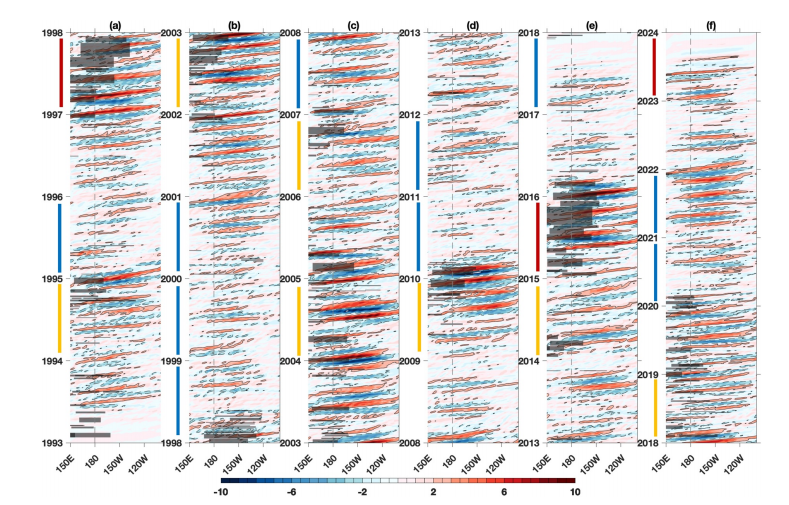
Figure 1 Spatiotemporal distribution of filtered sea level anomalies in the equatorial Pacific. Red/blue contours correspond to downwelling/upwelling Kelvin waves, respectively; gray shadows indicate the spatiotemporal distribution of concurrent WWB events. Red bars indicate Eastern Pacific El Niño years. Yellow bars indicated central-Pacific El Niño years. Blue bars indicate La Niña years.
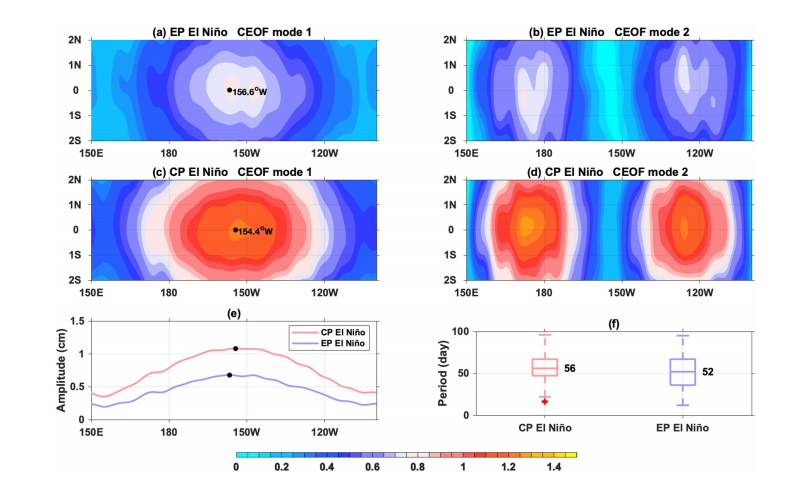
Figure 2 Main modal structures of Kelvin waves in EP and CP El Niño years
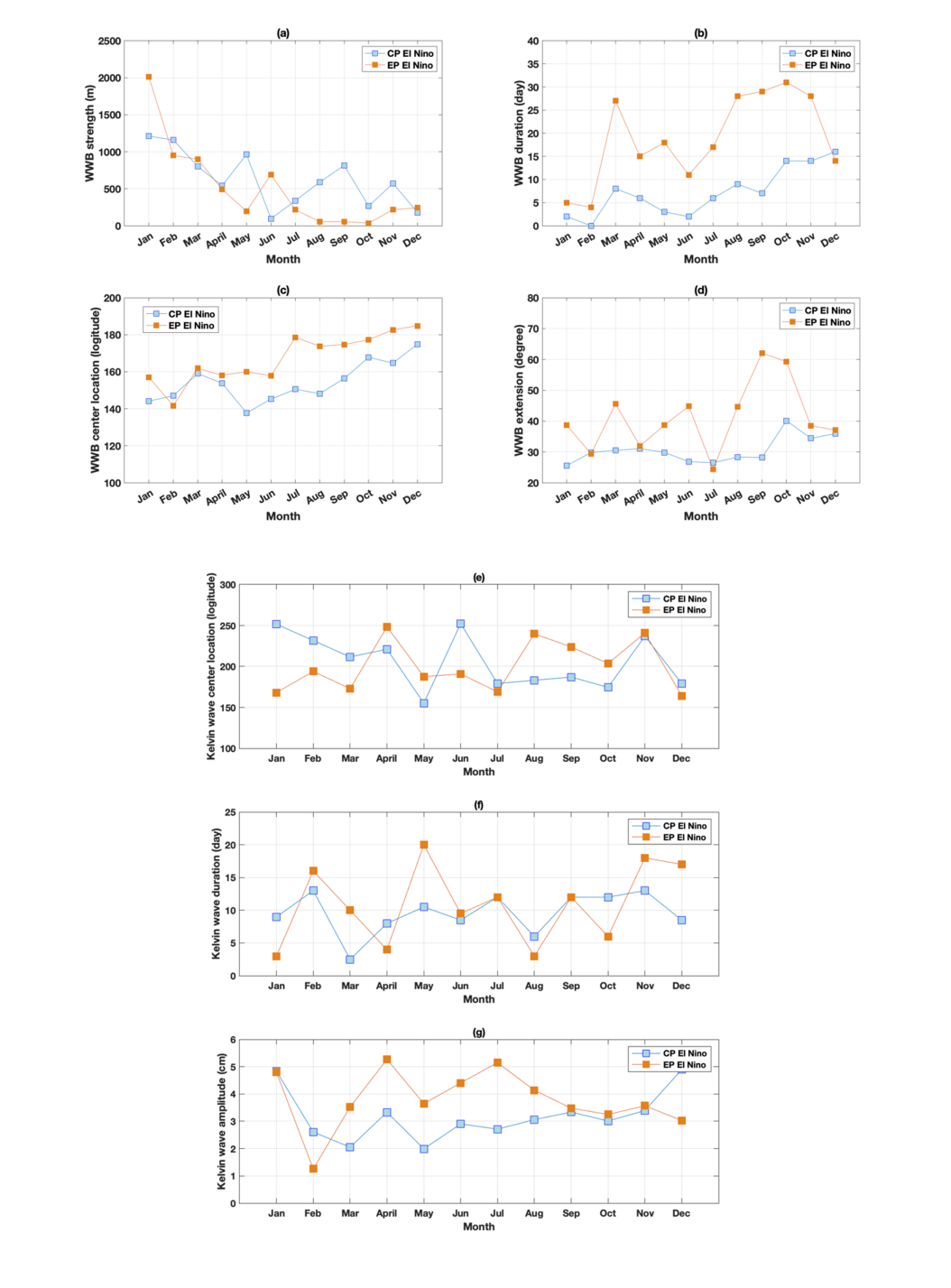
Figure 3 Quantitative comparison of characteristics such as intensity, duration, and location of WWBs and Kelvin waves in the two types of El Niño
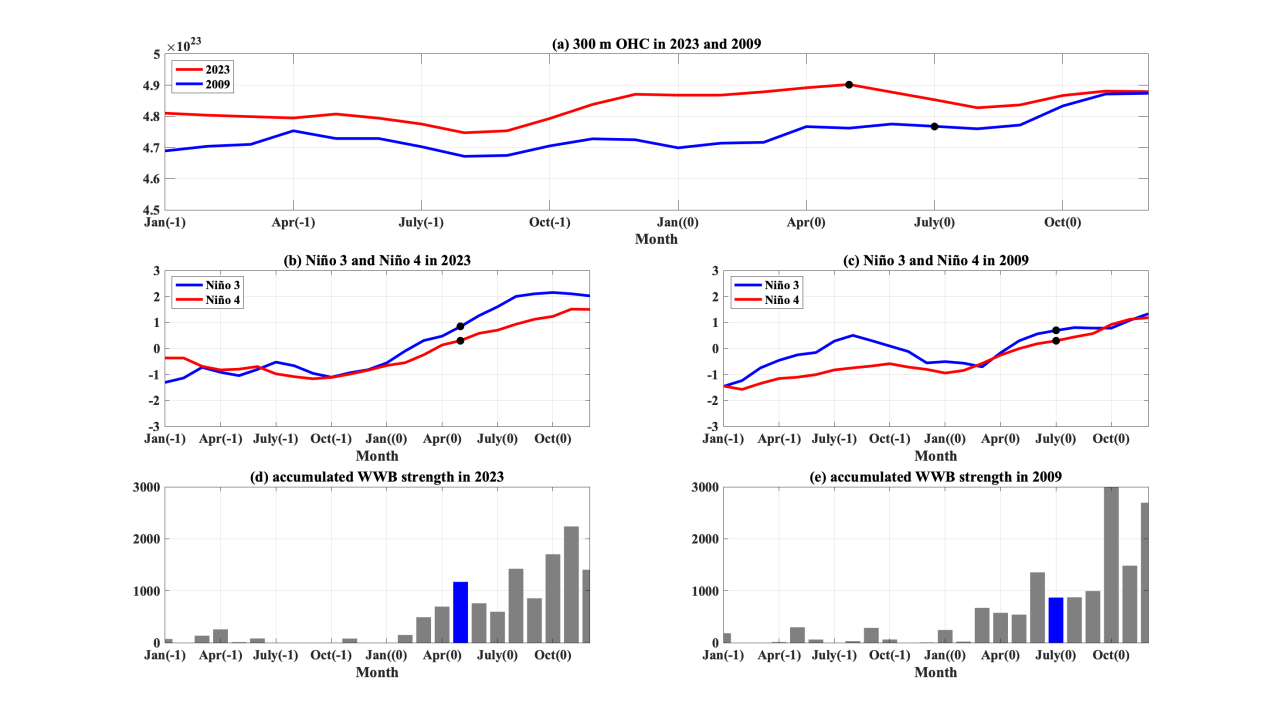
Figure 4 Evolution of ocean heat content, sea surface temperature, and WWBs in the CP El Niño event (2009) and EP El Niño event (2023)
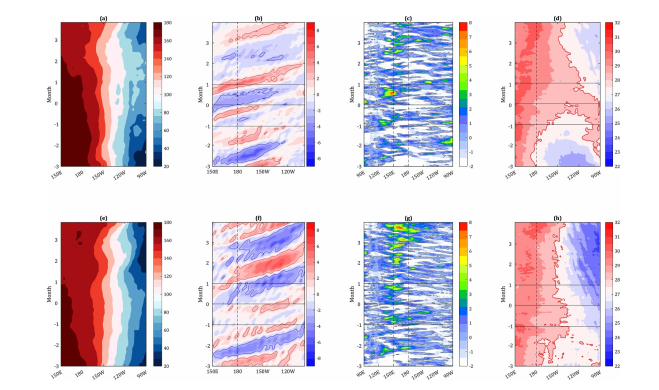
Figure 5 Spatiotemporal distribution of thermocline, Kelvin waves, WWBs, and sea surface temperature evolution in the two events